YAMAHA GRIZZLY 450 2014 Owners Manual
Manufacturer: YAMAHA, Model Year: 2014, Model line: GRIZZLY 450, Model: YAMAHA GRIZZLY 450 2014Pages: 174, PDF Size: 3.99 MB
Page 131 of 174
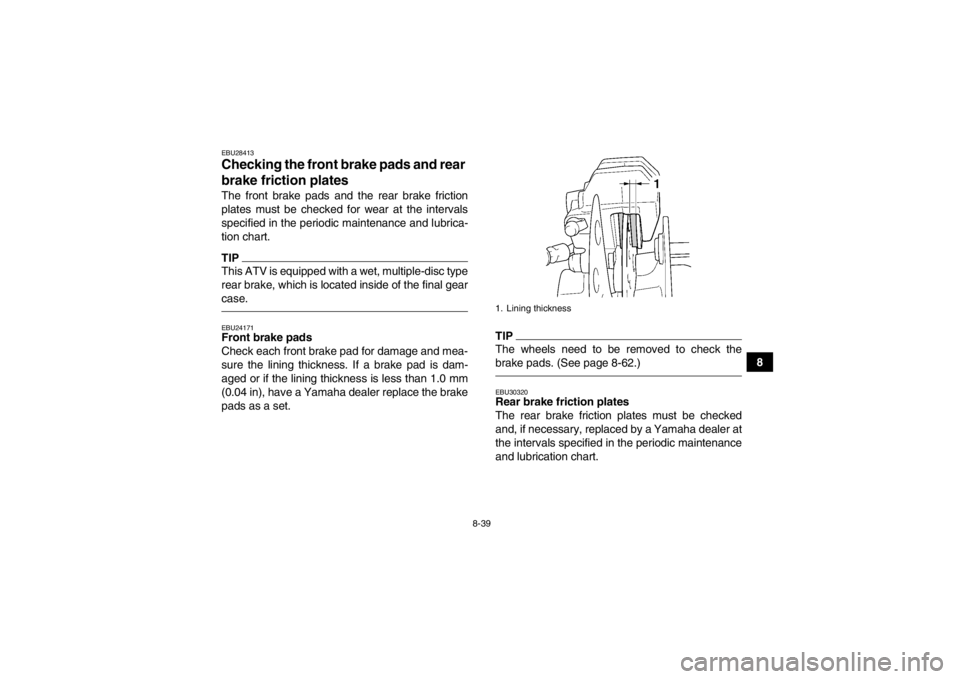
8-39
8
EBU28413Checking the front brake pads and rear
brake friction plates The front brake pads and the rear brake friction
plates must be checked for wear at the intervals
specified in the periodic maintenance and lubrica-
tion chart.TIPThis ATV is equipped with a wet, multiple-disc type
rear brake, which is located inside of the final gear
case.EBU24171Front brake pads
Check each front brake pad for damage and mea-
sure the lining thickness. If a brake pad is dam-
aged or if the lining thickness is less than 1.0 mm
(0.04 in), have a Yamaha dealer replace the brake
pads as a set.
TIPThe wheels need to be removed to check the
brake pads. (See page 8-62.)EBU30320Rear brake friction plates
The rear brake friction plates must be checked
and, if necessary, replaced by a Yamaha dealer at
the intervals specified in the periodic maintenance
and lubrication chart.1. Lining thickness
U2LC60E0.book Page 39 Friday, March 8, 2013 1:18 PM
Page 132 of 174
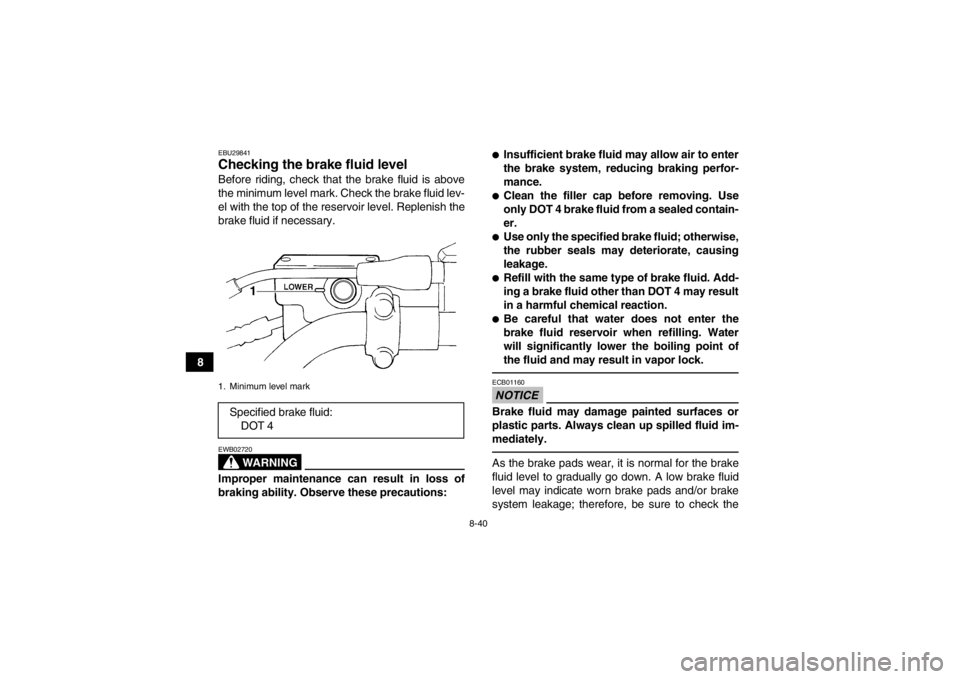
8-40
8
EBU29841Checking the brake fluid level Before riding, check that the brake fluid is above
the minimum level mark. Check the brake fluid lev-
el with the top of the reservoir level. Replenish the
brake fluid if necessary.
WARNING
EWB02720Improper maintenance can result in loss of
braking ability. Observe these precautions:
●Insufficient brake fluid may allow air to enter
the brake system, reducing braking perfor-
mance.●Clean the filler cap before removing. Use
only DOT 4 brake fluid from a sealed contain-
er.●Use only the specified brake fluid; otherwise,
the rubber seals may deteriorate, causing
leakage.●Refill with the same type of brake fluid. Add-
ing a brake fluid other than DOT 4 may result
in a harmful chemical reaction.●Be careful that water does not enter the
brake fluid reservoir when refilling. Water
will significantly lower the boiling point of
the fluid and may result in vapor lock.NOTICEECB01160Brake fluid may damage painted surfaces or
plastic parts. Always clean up spilled fluid im-
mediately.As the brake pads wear, it is normal for the brake
fluid level to gradually go down. A low brake fluid
level may indicate worn brake pads and/or brake
system leakage; therefore, be sure to check the
1. Minimum level markSpecified brake fluid:DOT 4
1
U2LC60E0.book Page 40 Friday, March 8, 2013 1:18 PM
Page 133 of 174
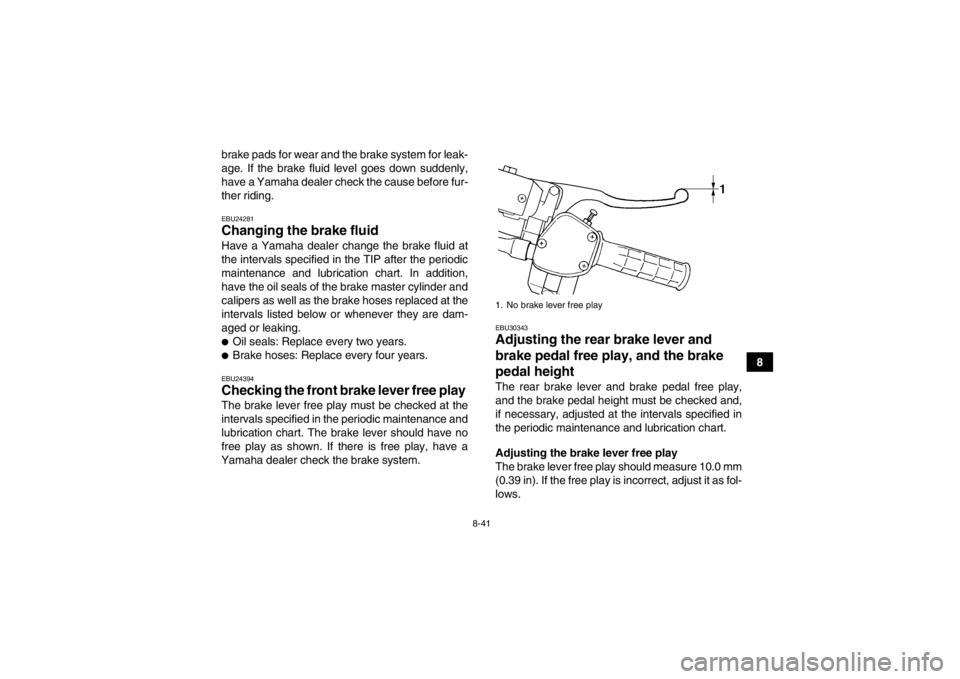
8-41
8
brake pads for wear and the brake system for leak-
age. If the brake fluid level goes down suddenly,
have a Yamaha dealer check the cause before fur-
ther riding.
EBU24281Changing the brake fluid Have a Yamaha dealer change the brake fluid at
the intervals specified in the TIP after the periodic
maintenance and lubrication chart. In addition,
have the oil seals of the brake master cylinder and
calipers as well as the brake hoses replaced at the
intervals listed below or whenever they are dam-
aged or leaking.●Oil seals: Replace every two years.●Brake hoses: Replace every four years.EBU24394Checking the front brake lever free play The brake lever free play must be checked at the
intervals specified in the periodic maintenance and
lubrication chart. The brake lever should have no
free play as shown. If there is free play, have a
Yamaha dealer check the brake system.
EBU30343Adjusting the rear brake lever and
brake pedal free pl ay, and the brake
pedal height The rear brake lever and brake pedal free play,
and the brake pedal height must be checked and,
if necessary, adjusted at the intervals specified in
the periodic maintenance and lubrication chart.
Adjusting the brake lever free play
The brake lever free play should measure 10.0 mm
(0.39 in). If the free play is incorrect, adjust it as fol-
lows.1. No brake lever free play
U2LC60E0.book Page 41 Friday, March 8, 2013 1:18 PM
Page 134 of 174
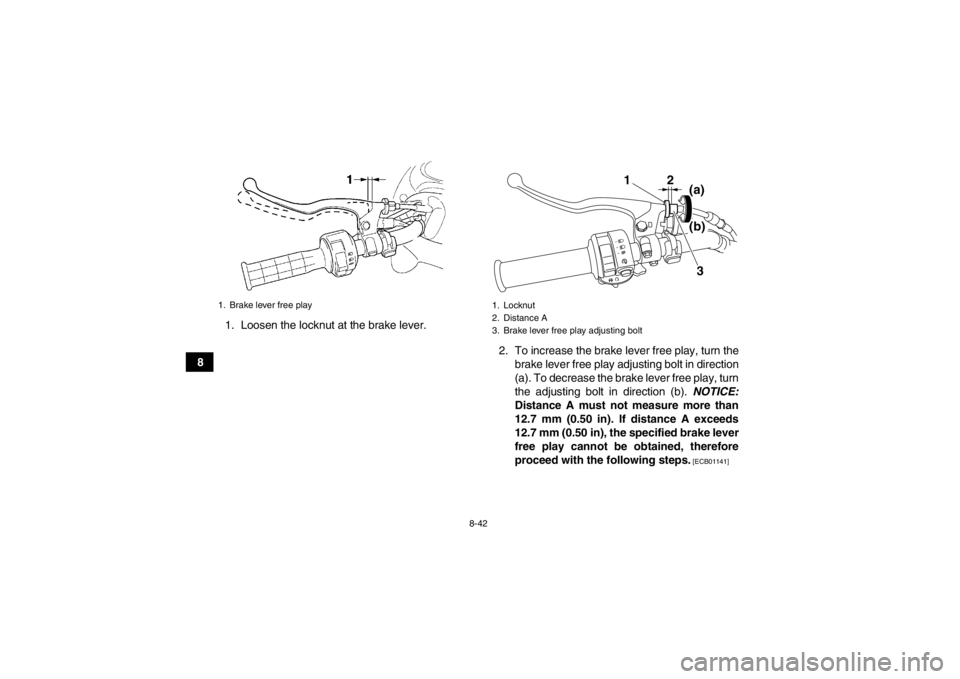
8-42
81. Loosen the locknut at the brake lever.
2. To increase the brake lever free play, turn thebrake lever free play adjusting bolt in direction
(a). To decrease the brake lever free play, turn
the adjusting bolt in direction (b). NOTICE:
Distance A must not measure more than
12.7 mm (0.50 in). If distance A exceeds
12.7 mm (0.50 in), the specified brake lever
free play cannot be obtained, therefore
proceed with the following steps.
[ECB01141]
1. Brake lever free play
1. Locknut
2. Distance A
3. Brake lever free play adjusting bolt
12
3
(a)
(b)
U2LC60E0.book Page 42 Friday, March 8, 2013 1:18 PM
Page 135 of 174
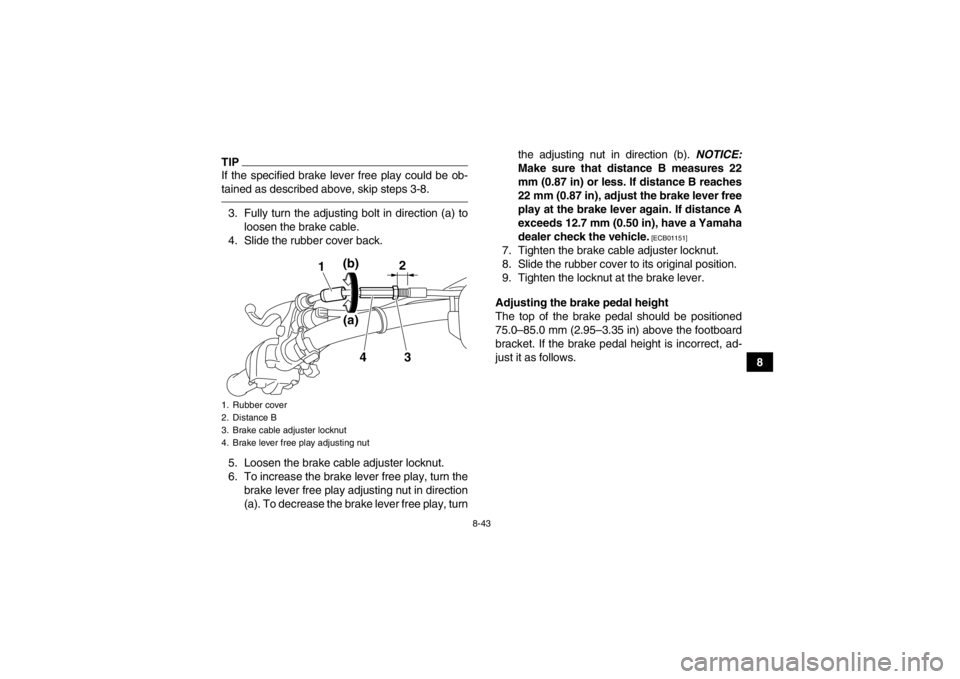
8-43
8
TIPIf the specified brake lever free play could be ob-
tained as described above, skip steps 3-8.3. Fully turn the adjusting bolt in direction (a) toloosen the brake cable.
4. Slide the rubber cover back.
5. Loosen the brake cable adjuster locknut.
6. To increase the brake lever free play, turn the brake lever free play adjusting nut in direction
(a). To decrease the brake lever free play, turn the adjusting nut in direction (b).
NOTICE:
Make sure that distance B measures 22
mm (0.87 in) or less. If distance B reaches
22 mm (0.87 in), adjust the brake lever free
play at the brake lever again. If distance A
exceeds 12.7 mm (0.50 in), have a Yamaha
dealer check the vehicle.
[ECB01151]
7. Tighten the brake cable adjuster locknut.
8. Slide the rubber cover to its original position.
9. Tighten the locknut at the brake lever.
Adjusting the brake pedal height
The top of the brake pedal should be positioned
75.0–85.0 mm (2.95–3.35 in) above the footboard
bracket. If the brake pedal height is incorrect, ad-
just it as follows.
1. Rubber cover
2. Distance B
3. Brake cable adjuster locknut
4. Brake lever free play adjusting nut
1
2
3
4
(b)(a)
U2LC60E0.book Page 43 Friday, March 8, 2013 1:18 PM
Page 136 of 174
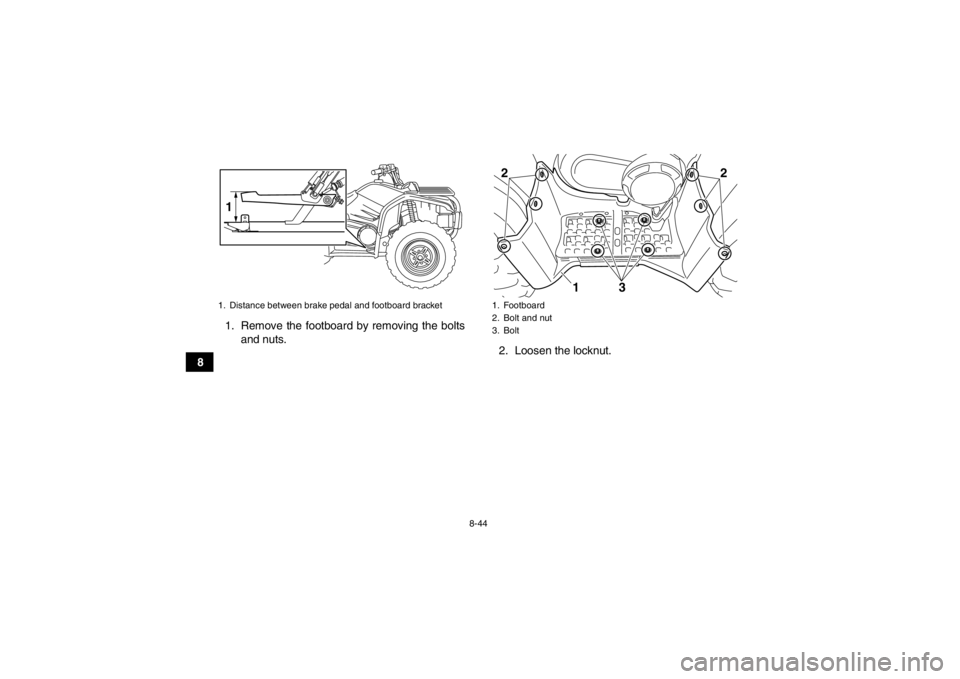
8-44
81. Remove the footboard by removing the bolts
and nuts. 2. Loosen the locknut.
1. Distance between brake pedal and footboard bracket1
1. Footboard
2. Bolt and nut
3. Bolt22
31
U2LC60E0.book Page 44 Friday, March 8, 2013 1:18 PM
Page 137 of 174
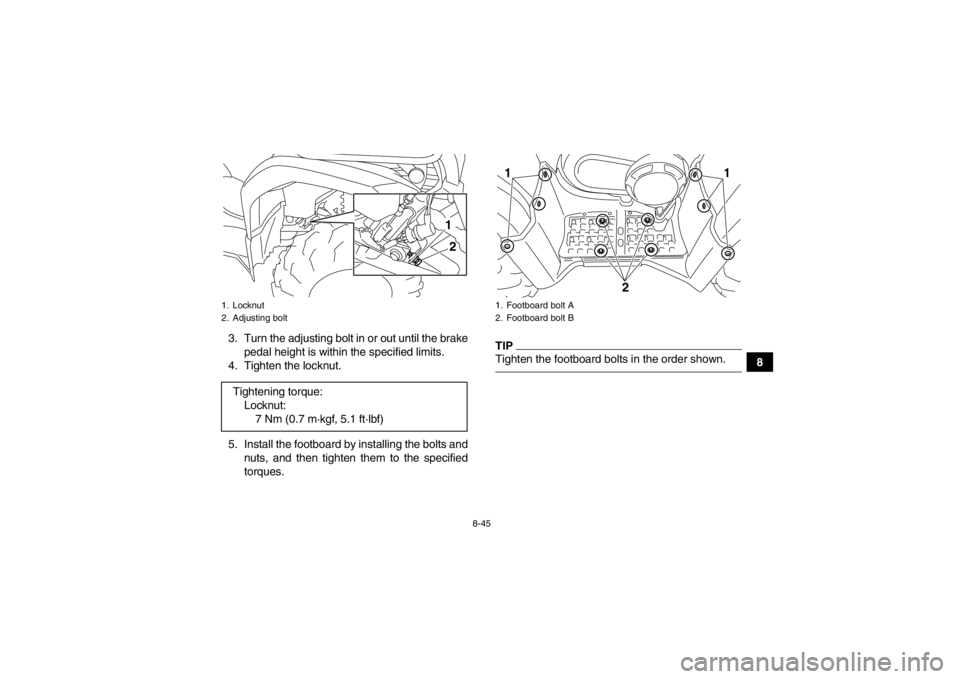
8-45
8
3. Turn the adjusting bolt in or out until the brake
pedal height is within the specified limits.
4. Tighten the locknut.
5. Install the footboard by installing the bolts and nuts, and then tighten them to the specified
torques.
TIPTighten the footboard bolts in the order shown.
1. Locknut
2. Adjusting boltTightening torque:Locknut:7 Nm (0.7 m·kgf, 5.1 ft·lbf)
21
1. Footboard bolt A
2. Footboard bolt B11
2
U2LC60E0.book Page 45 Friday, March 8, 2013 1:18 PM
Page 138 of 174
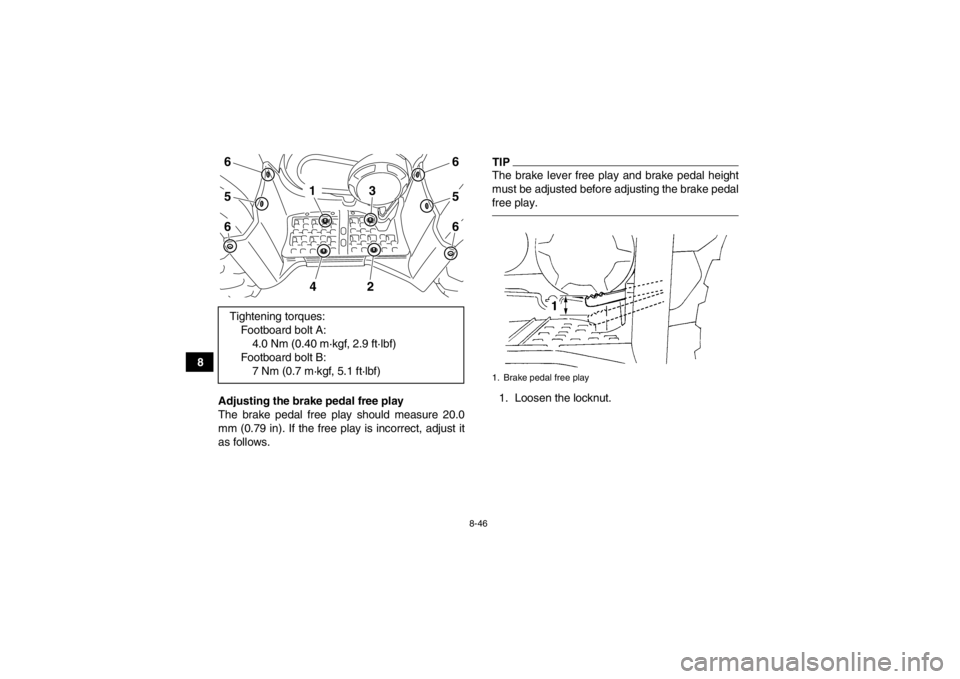
8-46
8Adjusting the brake pedal free play
The brake pedal free play should measure 20.0
mm (0.79 in). If the free play is incorrect, adjust it
as follows.
TIPThe brake lever free play and brake pedal height
must be adjusted before adjusting the brake pedal
free play.1. Loosen the locknut.
Tightening torques:
Footboard bolt A:4.0 Nm (0.40 m·kgf, 2.9 ft·lbf)
Footboard bolt B: 7 Nm (0.7 m·kgf, 5.1 ft·lbf)
656
656
2
4
3
1
1. Brake pedal free play
U2LC60E0.book Page 46 Friday, March 8, 2013 1:18 PM
Page 139 of 174
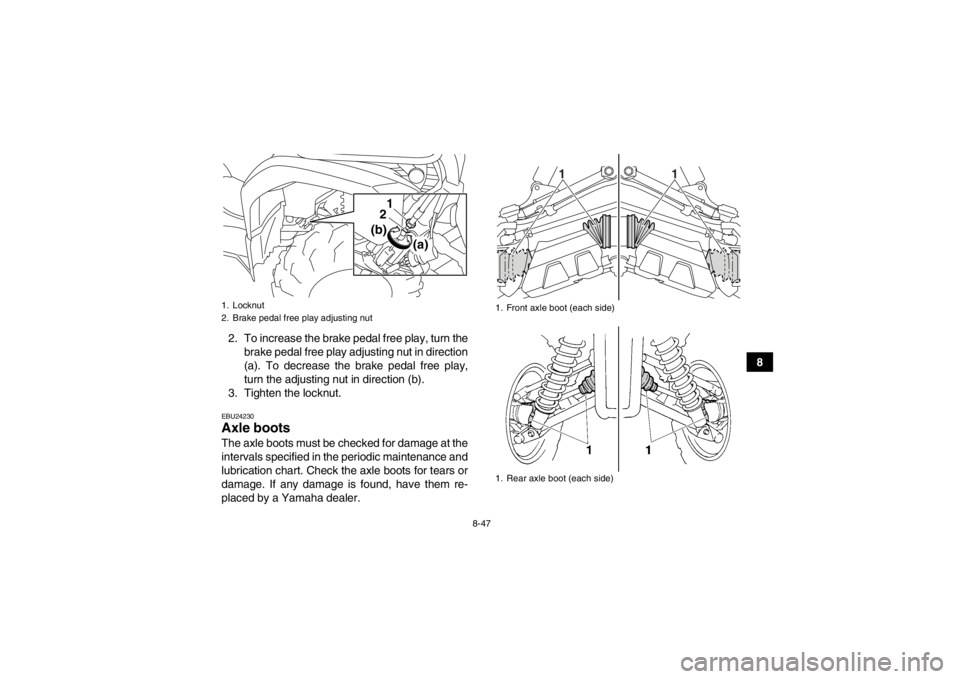
8-47
8
2. To increase the brake pedal free play, turn the
brake pedal free play adjusting nut in direction
(a). To decrease the brake pedal free play,
turn the adjusting nut in direction (b).
3. Tighten the locknut.
EBU24230Axle boots The axle boots must be checked for damage at the
intervals specified in the periodic maintenance and
lubrication chart. Check the axle boots for tears or
damage. If any damage is found, have them re-
placed by a Yamaha dealer.1. Locknut
2. Brake pedal free play adjusting nut
21
(a)
(b)
1. Front axle boot (each side)
1. Rear axle boot (each side)
1
1
U2LC60E0.book Page 47 Friday, March 8, 2013 1:18 PM
Page 140 of 174
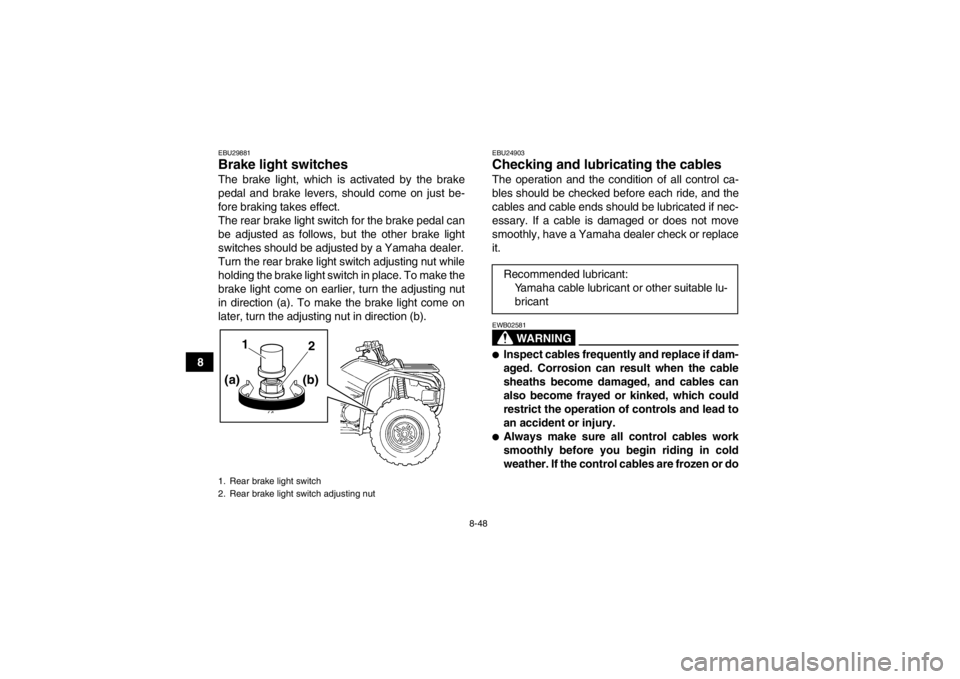
8-48
8
EBU29881Brake light switches The brake light, which is activated by the brake
pedal and brake levers, should come on just be-
fore braking takes effect.
The rear brake light switch for the brake pedal can
be adjusted as follows, but the other brake light
switches should be adjusted by a Yamaha dealer.
Turn the rear brake light switch adjusting nut while
holding the brake light switch in place. To make the
brake light come on earlier, turn the adjusting nut
in direction (a). To make the brake light come on
later, turn the adjusting nut in direction (b).
EBU24903Checking and lubricating the cables The operation and the condition of all control ca-
bles should be checked before each ride, and the
cables and cable ends should be lubricated if nec-
essary. If a cable is damaged or does not move
smoothly, have a Yamaha dealer check or replace
it.
WARNING
EWB02581●Inspect cables frequently and replace if dam-
aged. Corrosion can result when the cable
sheaths become damaged, and cables can
also become frayed or kinked, which could
restrict the operation of controls and lead to
an accident or injury.●Always make sure all control cables work
smoothly before you begin riding in cold
weather. If the control cables are frozen or do
1. Rear brake light switch
2. Rear brake light switch adjusting nut
1
2(b)
(a)
Recommended lubricant:
Yamaha cable lubricant or other suitable lu-bricant
U2LC60E0.book Page 48 Friday, March 8, 2013 1:18 PM